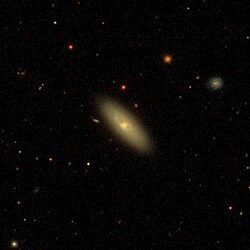| NGC 3843 | |
|---|---|
 NGC 3843 from the Sloan Digital Sky Survey NGC 3843 from the Sloan Digital Sky Survey | |
| Observation data (J2000 epoch) | |
| Constellation | Virgo |
| Right ascension | 11h 43m 54.6s |
| Declination | +07° 55′ 34″ |
| Redshift | 0.019707 |
| Heliocentric radial velocity | 5,854 km/s |
| Distance | 270 million light-years (83.2 Mpc) |
| Apparent magnitude (V) | 13.5 |
| Surface brightness | 12.4 mag/arcmin |
| Characteristics | |
| Type | S0-a |
| Apparent size (V) | 0.9′ × 0.4′ |
| Notable features | Lenticular galaxy in Virgo Cluster |
| Other designations | |
| PGC 36471, UGC 6699, MCG +1-30-11, CGCG 40-34 | |
NGC 3843 is a lenticular galaxy located in the constellation Virgo, first cataloged by the German-British astronomer William Herschel. Classified as type S0-a, it shows characteristics intermediate between elliptical and spiral galaxies, without prominent spiral arms. The galaxy has a visual magnitude of approximately 13.5, making it relatively faint and challenging to observe without larger telescopes. With an angular size of about 0.9 by 0.4 arcminutes, NGC 3843 is around 270 million light-years from Earth, determined by its redshift of 0.0197.
Characteristics
NGC 3843 is a lenticular galaxy of type S0-a, indicating that it has properties intermediate between elliptical and spiral galaxies. These characteristics are common in lenticular galaxies, which often feature a prominent central bulge and a faint, disk-like structure without distinct spiral arms. NGC 3843's apparent size is approximately 0.9 by 0.4 arcminutes, with a visual magnitude of 13.5, making it a dim object that requires moderate to large telescopes for observation.
The galaxy's redshift is measured at 0.019707, corresponding to a radial velocity of around 5,854 km/s, placing NGC 3843 roughly 270 million light-years (or 83.2 megaparsecs) from Earth. Its surface brightness of 12.4 mag/arcmin reflects its dim appearance against the background sky. As a member of the Virgo Cluster, NGC 3843 is situated among other galaxies in a dense region of space, which offers valuable insights into the evolution of lenticular galaxies within large galaxy clusters.
History
| This section does not cite any sources. Please help improve this section by adding citations to reliable sources. Unsourced material may be challenged and removed. (November 2024) (Learn how and when to remove this message) |
NGC 3843 was first cataloged by the German-British astronomer William Herschel, a key figure in the 18th century known for his systematic deep-sky surveys. Herschel’s extensive observations contributed to what would later become the New General Catalogue (NGC), a comprehensive listing of nebulae and galaxies compiled by John Louis Emil Dreyer in 1888.
The discovery of NGC 3843 took place during an era when astronomers were beginning to recognize the vastness of the universe beyond the Milky Way. Herschel’s work laid the groundwork for later astronomers who studied galaxies like NGC 3843 to understand their properties and distribution. With advancements in telescopic technology, 20th- and 21st-century surveys, such as the Sloan Digital Sky Survey (SDSS), have provided detailed images and data, revealing its structure as a lenticular galaxy within the Virgo Cluster.
References
- Astronomy, Go. "NGC 3843 | galaxy in Virgo | New General Catalogue". Go-Astronomy.com. Retrieved 2024-11-01.
- "NGC 3843". spider.seds.org. Retrieved 2024-11-01.
- "NGC 3843 - lenticular galaxy. Description NGC 3843:". kosmoved.ru. Retrieved 2024-11-01.